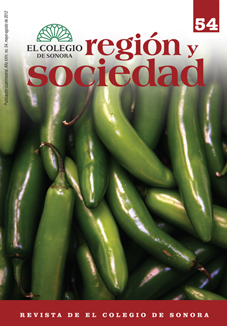 |
 |
 |
 |
 |
 |
 |
 |
 |
 |
 |
 |
Abstract
One century after the heyday of the inter-oceanic crossing through the Isthmus of Tehuantepec, where huge volumes of goods were moved between the Pacific and the Atlantic Oceans, the dawn of the 21st Century brings with it an interest in implementing a project, called Isthmus of Tehuantepec Logistic System, aimed at repositioning this southeastern Mexican region as a significant mobility hub linked to globalization's modern transportation networks. In this sense, this article aims to provide elements for the analysis of a potential multimodal corridor through the Isthmus of Tehuantepec, based on a structural-systemic approach which emphasizes the geo-economic determinations of a global area of networks and flows made up of production chains fragmented on a continental and/or planetary scale, whose integration requires new forms of transportation and communication.
References
Banco Mundial. 2006. Ingreso nacional bruto, método Atlas (US$ a precios actuales). http://datos.bancomundial.org/indicador/NY.GNP.ATLAS.CD/countries
Boske, Leigh y John C. Cuttino. 2003. Measuring the Economics and Transportation Impacts of Maritime-related Trade. Maritime Economics and Logistics V (2): 133-157.
Braudel, Fernand.1992. El Mediterráneo y el mundo mediterráneo en la época de Felipe II. México: Fondo de Cultura Económica (FCE).
----------. 1986. La dinámica del capitalismo. México: FCE.
Caravaca, Inmaculada, Gema González y Rocío Silva. 2005. Innovación, redes, recursos patrimoniales y desarrollo territorial. EURE XXXI (94): 5-24.
Castells, Manuel. 1997. La era de la información. Economía, sociedad y cultura. La sociedad red, volumen 1. Madrid: Alianza Editorial.
Castillo, Miguel Ángel. 2005. Tránsitos internacionales. Explosión inminente. T21, VII (75): 34-37.
CEPAL. 2007. El perfil marítimo. http://www.eclac.cl/perfil/default.asp. Santiago de Chile.
Comisión del Canal de Panamá. 2007. Estadísticas de flujos de carga en el canal de Panamá. http://www.pancanal.com/esp/op/transit-stats/
Containerization Internacional. 2006. Year Book. Emap Business Communications, New Jersey, U. S. A.
Guzmán, Luis. 1994. El Ferrocarril Nacional de Tehuantepec le abrió el camino al istmo de México. Salina Cruz Hoy I (1): 28-36.
IMT. 2009. Estudio de competitividad del corredor multimodal Ensenada-noreste de México-Estados Unidos. Documento interno inédito. Sanfandila, Querétaro, México.
Martner, Carlos. 2008. Transporte multimodal y globalización en México. México: Editorial Trillas.
----------. 2007. Reestructuración del espacio continental en el contexto global: corredores multimodales en Norte y Centroamérica. Economía, Territorio y Sociedad VII (25): 1-48.
----------. 2000. Retos del corredor transístmico en el marco de las redes globales de transporte. Mexicana de Sociología LXVII (3): 3-28.
Méndez, Ricardo. 1997. Geografía económica: la lógica espacial del capitalismo global. Barcelona: Ariel Geografía.
Mongelluzzo, Hill. 2003. East vs.West. The Journal of Commerce IV (11): 17-23.
Morales, Pedro. 1994. 123 años como puerto de altura está cumpliendo Salina Cruz. Salina Cruz Hoy I (1): 3-10.
Ohmae, Kenichi. 1985. Triad Power: The Coming Shape of Global Competition. Nueva York: Free Press.
PIERS. 2007. Ten Years Horizons. Statistic Report, Summer. Piers/Journal of Commerce.
Ruiz Cervantes, José. 1994. Promesas y saldos de un proyecto hecho realidad (1907-1940). En Economía contra sociedad. El istmo de Tehuantepec 1907-1986, compilado por Leticia Reina Aoyama, 91-137. México: Nueva Imagen.
San Martín, José. 1997. Análisis comparativo de competitividad entre los corredores de transporte internacional y el puente transístmico mexicano. Academia Mexicana de Ingeniería s/n-mimeografiado: 1-40.
Santos, Milton. 2000. La naturaleza del espacio. Barcelona: Ariel Geografía.
Sassen, Saskia. 2003. Localizando ciudades en circuitos globales. EURE XXIX (88): 5-27.
SCT. 2008. Anuncia el presidente Calderón el proyecto portuario más importante de México. http://www.sct.gob.mx/en/shownews/article/comunicado-de-prensa-no-167-anuncia-el-presidente-calderon-el-proyecto-portuario-mas-importante-d/ (28 de agosto de 2008).
Veltz, Pierre. 1999. Mundialización, ciudades y territorios. Barcelona: Ariel Geografía.
Wallerstein, Immanuel. 1996. Después del liberalismo. México: Siglo XXI Editores.
----------. 1992. Las lecciones de los ochenta. Argumentos V (15): 81-92.
Wood, Donald y James Johnson. 1990. Contemporary Transportation. Nueva York: Maxwell MacMillan.
Yocelevzky, Ricardo. 1999. La relevancia de las contribuciones de Immanuel Wallerstein para las ciencias sociales latinoamericanas. En Los intelectuales y los dilemas políticos en el siglo XX, tomo 1, compilado por Laura Baca e Isidro Cisneros, 131-165. México: Universidad Autónoma Metropolitana-Xochimilco.
Open access policy
The authors who publish in región y sociedad accept the following conditions:
In accordance with the copyright laws, región y sociedad recognizes and respects the authors’ moral rights, as well as the ownership of property rights, which will be transferred to the journal to disseminate the articles in open access. región y sociedad does not charge the authors for submitting and processing articles for publication.
All the texts published by región y sociedad —with no exception— are distributed under a Creative Commons license 4.0 Attribution – Noncommercial (CC BY-NC 4.0 International), which allows third parties to use the publication as long as they mention the works’ authorship and the first publication in this journal.
The authors can enter into independent and additional contractual agreements for the nonexclusive distribution of the version of the article published in región y sociedad (for instance include it into an institutional repository or publish it in a book) as long as they clearly indicate that the work was published for the first time in región y sociedad.
For all the above, the author(s) must send the Letter of transfer of property rights of the first publication duly filled in and signed by the author(s). This letter can be sent by e-mail as a PDF to: region@colson.edu.mx






